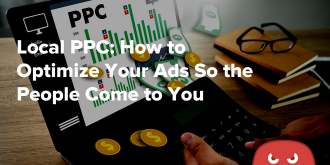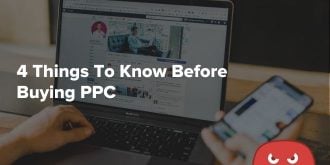Quick Links
It’s a given that any business will get phone calls. The challenge, of course, is to capture the data from every phone call so you can use it to grow your business. The solution? Call tracking and call tracking software.
In this article, we will explain call tracking, how it works and what data it can provide from phone calls (besides the typical phone numbers). Also, why your business needs and should be using call tracking. We’ll also look at Google Ads Call Tracking (which has some notorious drawbacks) and present a better call tracking solution. Read on if that sounds like the valuable, actionable info you’re searching for.
What is Call Tracking and Call Tracking Software?
Call tracking is a reporting and call recording software that empowers your business to track important details of incoming business phone calls. The data call tracking collects from inbound calls is as valuable as it gets, including who called, when they called, and what organization, if any, they represented.
Call tracking software also tells you where the caller was located and, most importantly, provides a transcript of all phone calls. In short, it gives you hard data on phone calls that your business can then use in a variety of business-building ways. You can use it to optimize your website content, for example, and to engage and attract more searchers and visitors.
Another excellent benefit of call tracking software is that marketers can identify which marketing campaign prompted the phone call, which greatly improves KPI measurement. It can also identify the keywords, ads, and web pages that drove the call to be placed.
Call tracking can also better measure online and offline marketing campaign performance. Sales teams employ call tracking software in advertising like Google Ads (PPC) to attribute which phone calls came from which place (and which phone numbers), so you know what marketing strategies are working and, more importantly, aren’t working.
How Does Call Tracking Software Work?
At its most basic, call tracking is when unique phone numbers are used for every marketing campaign a business runs. The reason for the unique phone numbers is simple; to tell the campaigns apart. When phone calls come in from a specific number, you know immediately to which campaign the caller is responding.
So, for example, XYZ Company decides to launch a marketing campaign (or several of them). The first thing that happens is that unique phone numbers are assigned, either local or 800 phone numbers. Those numbers can also lead to any desired department, including an office phone, marketing department, or 3rd-party answering service.
Once set up, phone calls go through phone tracking software when those phone numbers are called. The software is the key, allowing phone calls to be attributed to paid search, organic traffic, social media, and several other sources.
Dynamic phone numbers are also available that empower an advertiser to use as many numbers as they like and cover a variety of sources, marketing campaigns, and keywords. Call tracking software also incorporates scrips, cookies, “call whisper,” conversion settings, and more, giving an advertiser tremendous flexibility, improving their marketing campaigns significantly, and even working offline.
What are the Benefits of Call Tracking?
Call tracking with unique phone numbers, and call tracking software has many excellent benefits that today’s business owners simply can’t ignore. Most of them have to do with providing valuable call data and metrics. Still, all will help you improve your marketing campaigns, optimize content and give the correct attribution to the correct campaign. Some of the best benefits of call tracking software include:
- Call recording. Using call recording, you can identify customer service challenges and areas where improvement is needed, increasing conversions and sales.
- Call tracking lets you know which keywords are driving the most traffic to your website or landing page.
- With call tracking software, you can track the performance of your PC landing pages and determine which has the best conversion rates.
- Call duration is another excellent benefit of call tracking software. Statistically, longer, more in-depth calls produce higher conversion rates.
- Call tracking software identifies the marketing campaigns generating the most calls.
- With call tracking software and place, you will be able to market smarter using call attribution.
The Problem With Default Google Ads Call Tracking
Google’s default call tracking program is included in Google ads, but, unfortunately, it has some serious issues. For example, Google’s call tracking provides very few details about the caller and why they called. The limited data from Google’s call tracking include:
- The area code of the caller
- The length of the call
- The time of the call
- Which keyword or campaign drove the call
![]()
Worse still is that Google’s call tracking is unable to provide services that many other call tracking programs do provide, including:
- Conversion tracking is limited to the search network.
- The system can’t track multiple numbers.
- Call tracking is limited to AdWords.
- There is no call recording feature.
- All calls are recorded as conversions.
- Dynamic numbers expire after 90 days.
- Call tracking data can’t be integrated into Google Analytics.
- The system doesn’t provide a “request a call back” function
The lack of these 8 main features presents several drawbacks for businesses big and small:
- Your people won’t record many conversions triggered by Google ads.
- It’s impossible to know which number was used on the phone calls.
- You can’t compare the call volume from various sources.
- You can’t improve or optimize customer service.
- It’s impossible to tell if a phone call was a conversion or not.
- Users who call after 90 days won’t get through as the phone numbers will be expired.
- You can’t use analytics to make improvements or optimize content and SEO.
- Your business will inevitably miss sales as inbound calls are often missed.
A Better Call Tracking Solution
One way to fix Google’s out-of-the-box call tracking is to implement a separate, more advanced call-tracking solution. There are many call tracking software apps on the market today, including:
- Hubspot
- WhatConverts
- 800response
- ActiveDemand
- CallAction
- CallFire
- CallSource
- FluentStream
- Convirza
- Infinity
- Invoca
In our humble opinion, the best call tracking software is CallRail which we use for all our call tracking campaigns and inbound calls.
CallRail is a 3rd party software that allows a business to build tracking numbers and procure important details about phone calls not available in the standard Google Ads call tracking.
For call tracking to work, we first build tracking phone numbers that automatically forward the call to your main business line, allowing us to collect statistics on the phone call.
Doing this allows us to collect more detailed information, like:
- Exact Caller Number
- Call Time
- Call Length
- Call Source
- Call Recording
Here’s what it looks like:
![]()
This type of reporting gives much more detail, allows you to listen to recorded phone calls, and is significantly more accurate based on our research.
The Benefits Of Using Advanced Call Tracking
There are many excellent benefits to using advanced call tracking in your ad campaigns, especially to optimize them. So much so that we believe every paid ad campaign should include call tracking for the best results.
More Accurate Call Tracking
Most modern call tracking systems use cookies to track online activity. We’ve seen major differences between out-of-the-box Google Ads call tracking and our upgraded call tracking system using CallRail.
For example, using the CallRail call tracking software, 14-40%+ more phone calls are being reported. That means your business can:
- Determine who called, from where, and why
- Make significantly more callbacks to those phone numbers
- Better optimize your ad campaigns
You can use call analytics provided by the CallRail call tracking system to measure call-related metrics to determine conversion data effectively. For example, which Google Ads campaign generates the most phone calls for your business?
Answering that question is the call attribution report, one of the major call analytics provided by this improved call tracking system. Call attribution provides information on the marketing sources and interactions that generate the calls.
Killer Reporting Detail
In the past, with standard Google “Out Of The Box” tracking, you could see where calls were coming from, but qualifying them was almost impossible. That’s because Google’s Call Details report was severely limited.
![]()
With our advanced call tracking system, you get a whole new level of detail, including:
- Full phone number
- Call time
- Call length
- Call campaign
- Call recording
All of this valuable call recording data is provided on an intuitive, easy-to-use dashboard! There it’s simple to analyze each phone call quickly, see if the caller is qualified, export the call recording, or playback the call recording.
![]()
Call Recordings
Listening to call recordings may seem odd, but it is one of the most powerful tools to optimize marketing campaigns, improve conversion rates and revise, if necessary, your marketing strategy.
For example, if we hear prospects are interested in learning more about a specific service or feature, we can update the ad & landing page copy to match that need.
This single optimization increases conversion rates and brings in more qualified leads!
Listening lets you know which campaign produces qualified leads and double down on those efforts. A great example of this is below for a roofing company:
In the past, calls over 1-2 minutes were often seen as a positive lead indicator. However, gauging lead quality solely on the length of phone calls isn’t enough. We need to know if the phone call was a qualified lead, and the call content can give us that information.
In this 6-minute+ example, we found it was not for getting a new roof installed or repaired (the client’s main service) but instead was for roofing materials, a service they don’t offer.
![]()
The recording allowed us to identify this fact and optimize the campaign to prevent future irrelevant calls, saving the client time and money!
Removing Junk Call Sources
The final element of call recordings we use for optimization is figuring out where junk leads are coming from. You couldn’t qualify the leads with Google call tracking, which was a major drawback. Using Callrail, however, we know exactly where junk leads are emanating.
With CallRail, you can turn off specific aspects of your PPC campaign bringing in those junk leads, saving your team significant time and effort. Indeed, it’s given us the ability to optimize the campaign at an entirely new level.
Some of the optimizations we can make after listening to call recordings include:
- Ad copy adjustments
- Landing page copy adjustments
- Offer adjustments
- Follow up process adjustments
- Keyword changes
- And much more.
In short, call tracking with CallRail provides killer insight into what’s happening with the campaigns.
Call Tracking Case Studies & Results
Finally, let’s dive into the discrepancies we have seen while running this system for our HOTH PPC clients over the past few months.
Client Experiment #1
The first set of results is from a Lawyer. Calls and qualified leads are the heart of this campaign.
Inside Google Ads, we had 93 calls tracked. However, the same phone number using CallRail, had 142 calls tracked!
![]()
That’s 41% more calls tracked. Put another way, Google’s call tracking solution missed 41% of calls.
![]()
Even better, by listening to the calls, an important discovery was made: most of the calls were going directly to the client’s voicemail and not being picked up by an actual person!
We communicated this to the client and suggested a live receptionist take the incoming calls.
As you might imagine, the client was ecstatic that we uncovered this simple but vital piece of data!
Client Experiment #2
This client, also an attorney, informed us that inbound calls were extremely important to their business.
With Google Ads, we had 44 phone calls tracked.
![]()
With Callrail, we tracked 51 phone calls, a 14% increase.
![]()
More important than the increase, the call data allowed us to optimize the campaign. For example, we originally had 2 campaigns set up for this, one state-wide and one focused on a local area.
After listening to the recorded phone calls, we found that the city-specific campaign was producing higher call volume and higher quality leads. Our solution was to reallocate a portion of the monthly budget to the city-specific campaign.
Once done, more qualified leads started coming in, and the client is now seeing a significantly higher ROI for his campaigns.
Client Experiment #3
This last example is a roofing company. Their desire was as many qualified leads as possible for homeowners needing a new roof.
Before installing call tracking, we had decent metrics based on our predictions for this highly competitive market.
![]()
After we installed call tracking software, however, we were able to identify that callers were asking about competitors, jobs, and roofing supplies. In other words, many of the leads were not qualified leads.
Editor's note
Editor’s note
Today, we pre-optimize campaigns before we begin, using negative keyword lists to ensure we’re not showing up for terms that don’t fit the campaign.
Additionally, as part of our post-launch optimization process, we check the search term report daily to add new negative keywords and optimize campaigns even further.
Listening to calls gives us an entirely different data point – we’re able to find negative keyword ideas that don’t even show up on the search term report based on what the callers were asking for. This helps usensure you’re getting quality leads – not just hitting the numbers.
With this new data, we were able to add new negative keywords for specific competitors, jobs, and supplies. We also continue to monitor call quality, and we’re able to see a substantial improvement in inbound calls.
The thing is, numbers don’t tell the whole story. As a business owner, you don’t want a bunch of leads; you want a bunch of quality leads. A better call tracking solution can make all the difference in your campaigns, enhance your marketing efforts, and improve your SEO.
Conclusion- Call Tracking Makes Good Business Sense
When you’re spending money on PPC, getting as much raw data as possible is essential. This raw data allows you to optimize your marketing campaigns, which is why advanced call tracking is a service we believe all businesses should employ! Call tracking eliminates wasted efforts, maintains quality, and keeps new leads rolling in.
There’s no legitimate reason to miss the mark by 40% or more on campaign reporting with call tracking software in place!
Need help with your PPC campaigns? Have questions about call tracking, optimizing ad campaigns, or implementing CallRail call tracking for your business? If yes, check out HOTH PPC today or contact us, and someone will get back to you asap.








Thanks for sharing about this call-tracking software. Call-tracking software is relevant in lead generation in business as long as they have the consent of the customers. Nice Content.